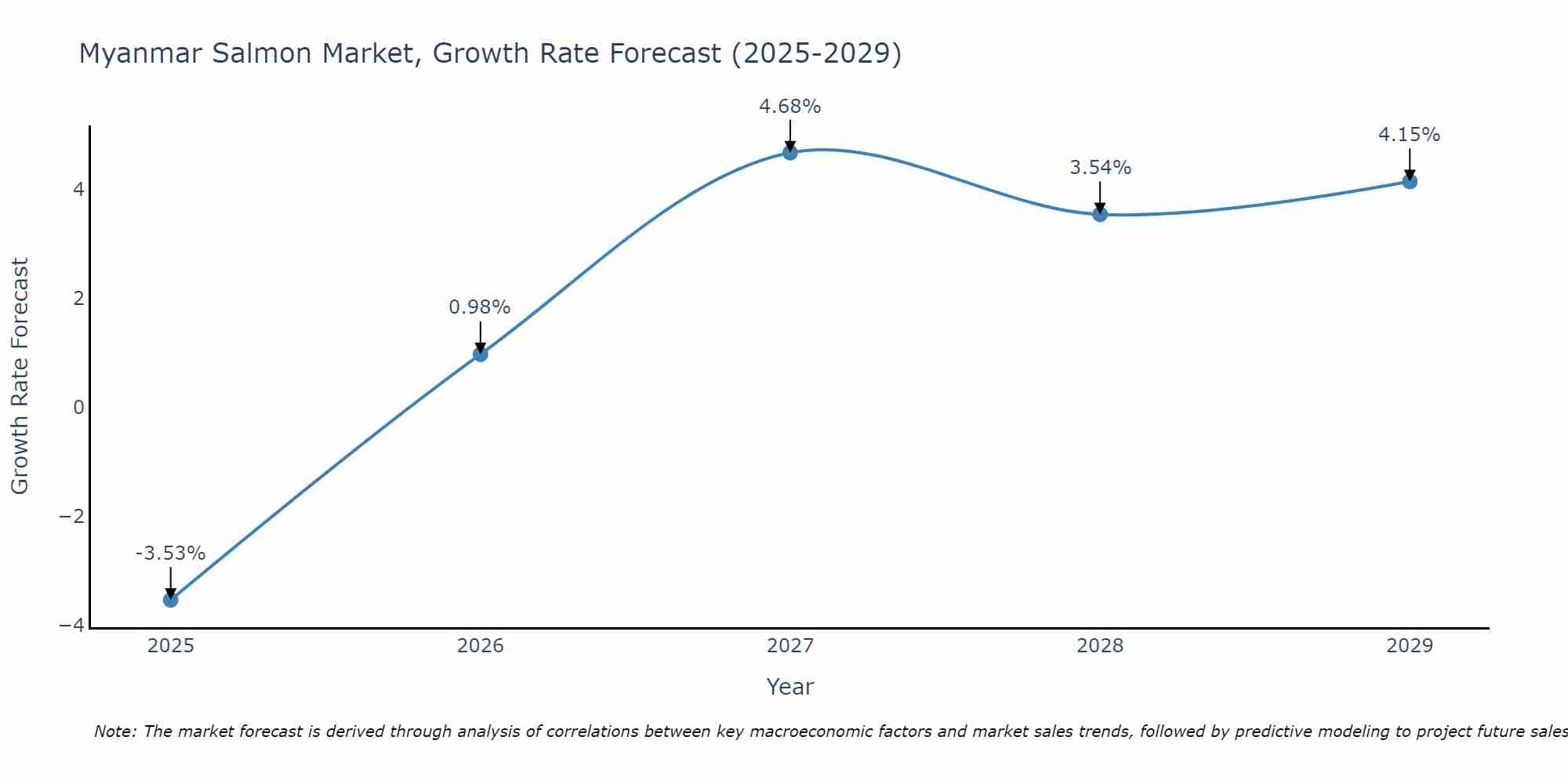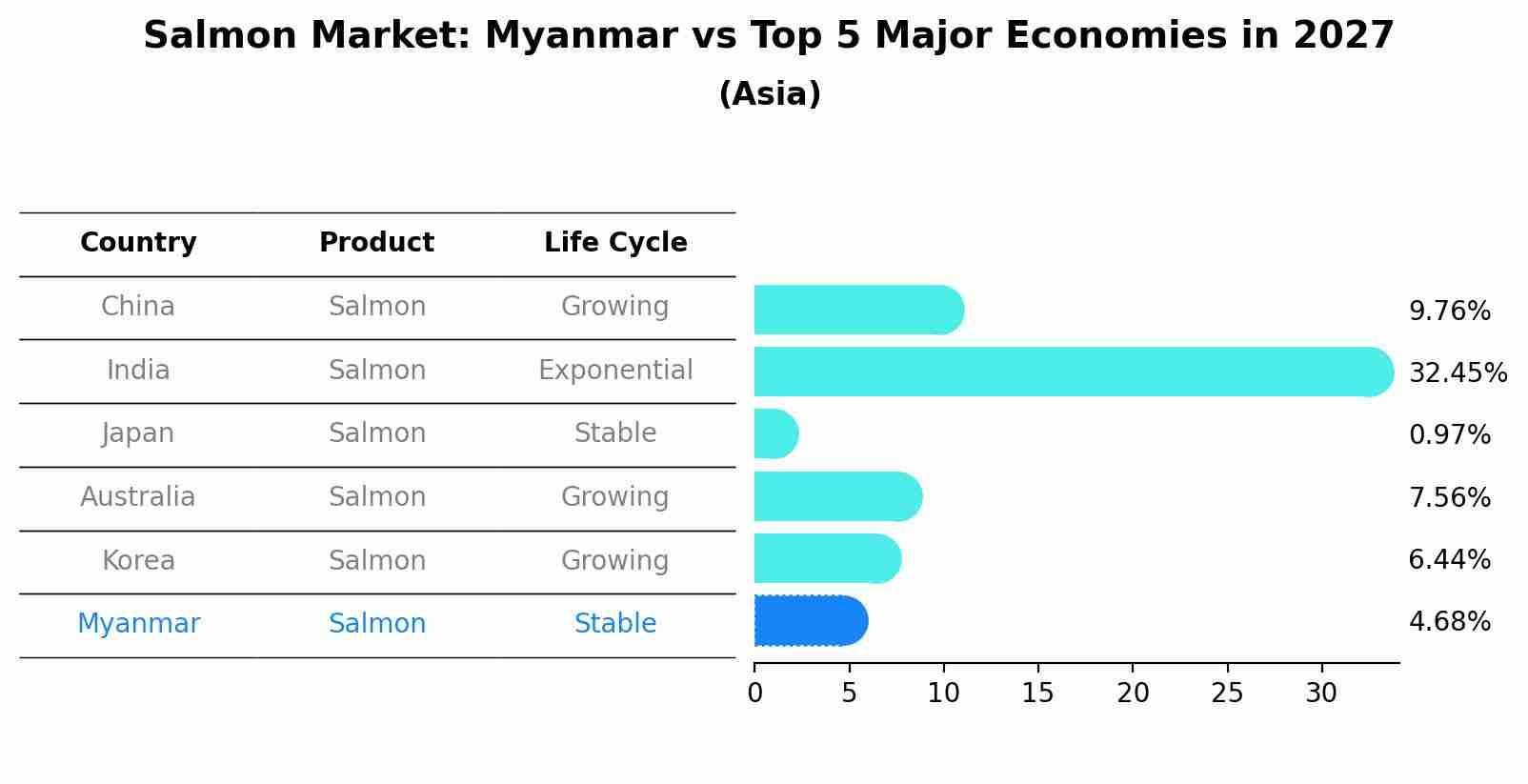Myanmar Salmon Market (2025-2031) Outlook | Trends, Revenue, Industry, Value, Share, Growth, Companies, Analysis, Size & Forecast
| Product Code: ETC387634 | Publication Date: Aug 2022 | Updated Date: Jul 2025 | Product Type: Market Research Report | |
| Publisher: 6Wresearch | Author: Shubham Deep | No. of Pages: 75 | No. of Figures: 35 | No. of Tables: 20 |
Myanmar Salmon Market Size Growth Rate
The Myanmar Salmon Market is projected to witness mixed growth rate patterns during 2025 to 2029. Starting at -3.53% in 2025, the market peaks at 4.68% in 2027, and settles at 4.15% by 2029.

Salmon Market: Myanmar vs Top 5 Major Economies in 2027 (Asia)
In the Asia region, the Salmon market in Myanmar is projected to expand at a stable growth rate of 4.68% by 2027. The largest economy is China, followed by India, Japan, Australia and South Korea.

Myanmar Salmon Market Synopsis
The Myanmar Salmon Market is a niche segment within the country`s seafood industry, primarily driven by the growing demand for imported salmon among the urban population and expatriates. While fresh local salmon is not readily available in Myanmar due to its tropical climate, imported salmon products, such as smoked salmon, salmon fillets, and canned salmon, are increasingly popular in high-end supermarkets and restaurants. The market is predominantly supplied by imports from countries like Norway, Scotland, and Chile, with a focus on quality and sustainability. Despite being a relatively small market compared to other seafood products, the Myanmar Salmon Market presents opportunities for growth as consumer awareness of salmon`s health benefits and culinary versatility continues to rise, particularly among the affluent and health-conscious demographic.
Myanmar Salmon Market Trends
The Myanmar salmon market is experiencing a growing demand for imported salmon products due to increasing consumer interest in healthy and diverse food options. The market is seeing a rise in the availability of fresh and frozen salmon products from countries like Norway and Canada, as well as an expansion in the variety of salmon-based dishes offered at restaurants and supermarkets. Consumers are becoming more knowledgeable about the health benefits of salmon, such as its high omega-3 fatty acid content, leading to a shift towards incorporating salmon into their diets. Additionally, the rise of online grocery platforms and specialty seafood stores is making it easier for consumers to access a wider range of salmon products, contributing to the overall growth of the salmon market in Myanmar.
Myanmar Salmon Market Challenges
The Myanmar Salmon Market faces several challenges primarily due to its landlocked geography and lack of access to fresh seafood sources. Importing salmon can be costly and logistically complex, resulting in limited availability and high prices for consumers. Additionally, the lack of awareness and demand for salmon in Myanmar further hinders market growth. Quality control and maintaining freshness during transportation can also be challenging, impacting the overall quality of the product reaching consumers. The competition from locally favored fish varieties further adds to the market challenges. Overcoming these hurdles would require strategic partnerships with international suppliers, educating consumers about the benefits of salmon, and implementing efficient cold chain logistics to ensure quality and availability in the market.
Myanmar Salmon Market Investment Opportunities
The Myanmar salmon market presents promising investment opportunities due to increasing demand for high-quality seafood products in the region. With a growing middle-class population and rising consumer awareness about health benefits of salmon, there is a potential for expansion and profitability in this market. Investors could consider opportunities in salmon farming operations, distribution networks, or seafood processing facilities to capitalize on the growing demand. Additionally, partnerships with local fishery companies or government initiatives to promote aquaculture could further enhance the market potential. However, it is essential to conduct thorough market research, assess regulatory frameworks, and consider sustainability practices to ensure long-term success in the Myanmar salmon market.
Jordan Agar Market Government Policies
Government policies related to the Myanmar Salmon Market are primarily focused on promoting sustainable fishing practices and ensuring the conservation of salmon populations. The government has implemented regulations to control fishing seasons, catch limits, and gear restrictions to prevent overfishing and protect the environment. Additionally, efforts are being made to increase aquaculture production of salmon to meet the growing demand while reducing pressure on wild populations. The government is also working towards improving market access for small-scale fishers and promoting fair trade practices within the industry. Overall, the government`s policies aim to balance economic opportunities with environmental conservation in the Myanmar Salmon Market.
Myanmar Salmon Market Future Outlook
The future outlook for the Myanmar Salmon Market appears to be promising as the demand for salmon and other seafood products is expected to rise in the country due to increasing consumer awareness about the health benefits of seafood consumption. With a growing middle-class population and improving economic conditions, more consumers in Myanmar are likely to have the disposable income to afford premium seafood products like salmon. However, challenges such as infrastructure limitations and competition from other seafood options may impact market growth. Overall, the Myanmar Salmon Market is poised for expansion in the coming years, driven by changing consumer preferences and economic development in the country.
Key Highlights of the Report:
- Myanmar Salmon Market Outlook
- Market Size of Myanmar Salmon Market, 2024
- Forecast of Myanmar Salmon Market, 2031
- Historical Data and Forecast of Myanmar Salmon Revenues & Volume for the Period 2021 - 2031
- Myanmar Salmon Market Trend Evolution
- Myanmar Salmon Market Drivers and Challenges
- Myanmar Salmon Price Trends
- Myanmar Salmon Porter's Five Forces
- Myanmar Salmon Industry Life Cycle
- Historical Data and Forecast of Myanmar Salmon Market Revenues & Volume By Type for the Period 2021 - 2031
- Historical Data and Forecast of Myanmar Salmon Market Revenues & Volume By Chinook Salmon for the Period 2021 - 2031
- Historical Data and Forecast of Myanmar Salmon Market Revenues & Volume By Coho Salmon for the Period 2021 - 2031
- Historical Data and Forecast of Myanmar Salmon Market Revenues & Volume By Pink Salmon for the Period 2021 - 2031
- Historical Data and Forecast of Myanmar Salmon Market Revenues & Volume By Red Salmon for the Period 2021 - 2031
- Historical Data and Forecast of Myanmar Salmon Market Revenues & Volume By Salmo Salar for the Period 2021 - 2031
- Historical Data and Forecast of Myanmar Salmon Market Revenues & Volume By Silverbrite Salmon for the Period 2021 - 2031
- Historical Data and Forecast of Myanmar Salmon Market Revenues & Volume By End Product Type for the Period 2021 - 2031
- Historical Data and Forecast of Myanmar Salmon Market Revenues & Volume By Fresh for the Period 2021 - 2031
- Historical Data and Forecast of Myanmar Salmon Market Revenues & Volume By Frozen for the Period 2021 - 2031
- Historical Data and Forecast of Myanmar Salmon Market Revenues & Volume By Canned for the Period 2021 - 2031
- Historical Data and Forecast of Myanmar Salmon Market Revenues & Volume By Others for the Period 2021 - 2031
- Historical Data and Forecast of Myanmar Salmon Market Revenues & Volume By Distribution Channel for the Period 2021 - 2031
- Historical Data and Forecast of Myanmar Salmon Market Revenues & Volume By Retail Stores for the Period 2021 - 2031
- Historical Data and Forecast of Myanmar Salmon Market Revenues & Volume By Hypermarket/supermarket for the Period 2021 - 2031
- Historical Data and Forecast of Myanmar Salmon Market Revenues & Volume By Online Sales Channels for the Period 2021 - 2031
- Myanmar Salmon Import Export Trade Statistics
- Market Opportunity Assessment By Type
- Market Opportunity Assessment By End Product Type
- Market Opportunity Assessment By Distribution Channel
- Myanmar Salmon Top Companies Market Share
- Myanmar Salmon Competitive Benchmarking By Technical and Operational Parameters
- Myanmar Salmon Company Profiles
- Myanmar Salmon Key Strategic Recommendations
Frequently Asked Questions About the Market Study (FAQs):
- Single User License$ 1,995
- Department License$ 2,400
- Site License$ 3,120
- Global License$ 3,795
Search
Thought Leadership and Analyst Meet
Our Clients
Related Reports
- Canada Oil and Gas Market (2026-2032) | Share, Segmentation, Value, Industry, Trends, Forecast, Analysis, Size & Revenue, Growth, Competitive Landscape, Outlook, Companies
- Germany Breakfast Food Market (2026-2032) | Industry, Share, Growth, Size, Companies, Value, Analysis, Revenue, Trends, Forecast & Outlook
- Australia Briquette Market (2025-2031) | Growth, Size, Revenue, Forecast, Analysis, Trends, Value, Share, Industry & Companies
- Vietnam System Integrator Market (2025-2031) | Size, Companies, Analysis, Industry, Value, Forecast, Growth, Trends, Revenue & Share
- ASEAN and Thailand Brain Health Supplements Market (2025-2031) | Strategy, Consumer Insights, Analysis, Investment Trends, Opportunities, Growth, Size, Share, Industry, Revenue, Segments, Value, Segmentation, Supply, Forecast, Restraints, Outlook, Competition, Drivers, Trends, Demand, Pricing Analysis, Competitive, Strategic Insights, Companies, Challenges
- ASEAN Bearings Market (2025-2031) | Strategy, Consumer Insights, Analysis, Investment Trends, Opportunities, Growth, Size, Share, Industry, Revenue, Segments, Value, Segmentation, Supply, Forecast, Restraints, Outlook, Competition, Drivers, Trends, Demand, Pricing Analysis, Competitive, Strategic Insights, Companies, Challenges
- Europe Flooring Market (2025-2031) | Outlook, Share, Industry, Trends, Forecast, Companies, Revenue, Size, Analysis, Growth & Value
- Saudi Arabia Manlift Market (2025-2031) | Outlook, Size, Growth, Trends, Companies, Industry, Revenue, Value, Share, Forecast & Analysis
- Uganda Excavator, Crane, and Wheel Loaders Market (2025-2031) | Strategy, Consumer Insights, Analysis, Investment Trends, Opportunities, Growth, Size, Share, Industry, Revenue, Segments, Value, Segmentation, Supply, Forecast, Restraints, Outlook, Competition, Drivers, Trends, Demand, Pricing Analysis, Competitive, Strategic Insights, Companies, Challenges
- Rwanda Excavator, Crane, and Wheel Loaders Market (2025-2031) | Strategy, Consumer Insights, Analysis, Investment Trends, Opportunities, Growth, Size, Share, Industry, Revenue, Segments, Value, Segmentation, Supply, Forecast, Restraints, Outlook, Competition, Drivers, Trends, Demand, Pricing Analysis, Competitive, Strategic Insights, Companies, Challenges
Industry Events and Analyst Meet
Whitepaper
- Middle East & Africa Commercial Security Market Click here to view more.
- Middle East & Africa Fire Safety Systems & Equipment Market Click here to view more.
- GCC Drone Market Click here to view more.
- Middle East Lighting Fixture Market Click here to view more.
- GCC Physical & Perimeter Security Market Click here to view more.
6WResearch In News
- Doha a strategic location for EV manufacturing hub: IPA Qatar
- Demand for luxury TVs surging in the GCC, says Samsung
- Empowering Growth: The Thriving Journey of Bangladesh’s Cable Industry
- Demand for luxury TVs surging in the GCC, says Samsung
- Video call with a traditional healer? Once unthinkable, it’s now common in South Africa
- Intelligent Buildings To Smooth GCC’s Path To Net Zero


















